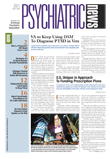Early diagnosis and intervention—either psychotherapeutic or pharmacological—following trauma may some day reduce symptoms of posttraumatic stress disorder (PTSD), said two researchers with different perspectives on the issue.
“Many people suffer PTSD symptoms immediately after an exposure to trauma, but most of them recover within the next three months without formal health intervention,” said Richard Bryant, Ph.D., the Scientia Professor in the School of Psychology at Australia's University of New South Wales.“ The real question is how to identify shortly after an event people who will be at high risk for PTSD later, as opposed to those having transient stress reactions.”
Bryant spoke at a conference on early psychological intervention following mass trauma sponsored by the Department of Psychiatry and Behavioral Sciences and the School of Public Health at the New York Medical College in Valhalla, N.Y. He argued for improved diagnostic approaches and for innovative ways of treating the large number of patients to be expected following major disasters like hurricanes or terror attacks.
At the same meeting, Matthew Friedman, M.D., Ph.D., executive director of the Department of Veterans Affairs' National center for Post-Traumatic Stress Disorder in White River Junction, Vt., reported on promising avenues of research involving the action of neurotransmitters in specific areas of the brain.
The term “acute stress disorder” (ASD) was introduced in 1994 as a kind of precursor to PTSD, recalled Bryant. DSM-IV says that ASD could be diagnosed two days after trauma, but this assumed a momentary event, said Bryant. Long-lasting trauma like Hurricane Katrina or service in Iraq might continue for extended periods, so the “end” of traumatic exposure had to be reckoned not by the calendar but by the patient's experience and the context of the event. Also, remission frequently occurred in the first week following trauma, so two days was too early to make a diagnosis, he said in disagreement with the DSM-IV standards.
Much of the thinking about PTSD has depended on an early diagnosis of ASD, but there are two problems with that, said Bryant. Since 1994, a dozen prospective studies have examined the hypothesized links between ASD and PTSD. These studies showed, however, that while a high percentage of those who have ASD after trauma go on to develop PTSD, a much lower percentage of those with PTSD were ever diagnosed with ASD. Much has also made of dissociation in response to trauma as a critical part of ASD and a source of ongoing mental disorder, he said, but dissociation was a misleading diagnostic term.
“Dissociation is not the key,” said Bryant. “If you include it, then you will miss a lot of PTSD cases. The stress of the event is the best predictor of PTSD.”
Cognitive models—how the victim understands and appraises the stressful experience—are influential, and cognitive style also helps predict the occurrence of PTSD. Furthermore, cognitive-behavioral therapy (CBT) appears to work in response, especially when compared with supportive counseling, his own research has shown.
“Can we apply this knowledge to make a difference in mass trauma events?” asked Bryant. “The limitations are daunting.”
Thousands of people may need help, but mobilizing enough mental health professionals to do formal early interventions is nearly impossible. CBT works, but new ways have to be devised to deliver it to large numbers of people, he suggested.
“Ninety percent of CBT is self-help, done outside the office, so let's put it on the Web,” said Bryant. Web-based therapy could take a modular approach, he said. People could take a self-test, then be shifted to other pages for instruction in CBT. Whether this would work is not known, he said.
“We must set up a trial in a controlled way,” he said.“ We need to develop strategies to assist those who can benefit from CBT strategies and find creative means of delivery—but these need to be tested empirically.”
Research has been leading to better understanding of how PTSD manifests itself in the brain and may provide targets for intervention right after trauma, said Friedman.
PTSD is a disorder of reactivity, he said. Control is carried out by neurotransmitters that serve to prime the stress system when it is needed for protection, but it has negative consequences when it overreacts.
For instance, norepinephrine is normally effective in mobilizing fear, the flight response, and sympathetic activation and consolidating memory. Too much norepinephrine, however, induces hypervigilance, autonomic arousal, flashbacks, and intrusive memories. In acute response to trauma, serotonin promotes self-defense, rage, and attenuation of fear, but too little serotonin results in aggression, violence, impulsivity, depression, and anxiety.
“The problem in PTSD is that the `on' switch is stuck on `on,'” said Friedman. The body needs to mobilize just enough but no more.
A possible pharmacological intervention to treat acute stress, a“ morning-after pill,” would focus on upstream mechanisms and reduce corticotropin releasing factor activity, normalize hypothalamicpituitary-adrenal axis function, reduce locus ceruleus/norepinephrine activation, and normalize immunologic function.
Such an acute intervention, given shortly after trauma, might simultaneously reduce excessive stress responses, enhance inadequate stress responses, and promote rapid recovery of normal functioning. It might thus shorten the recovery time following a traumatic event.
Several compounds have been suggested as candidates: beta-blockers, hydrocortisone, tricyclic antidepressants, risperidone, and benzodiazepines. Corticotropin releasing factor antagonists have been tried in animals but are not yet ready for humans. Another important area in neuroscience research is the rapid neurotransmitters, like gamma-aminobutyric acid (GABA, an inhibitory neurotransmitter) and glutamate (a major excitatory neurotransmitter), he said.
Friedman went a step further in suggesting that it might someday be possible to identify children at risk and “inoculate” them against PTSD by teaching about stress and how to cope with it in the schools, much like sex education is taught today. Also, since most people get over stressful events, there has been a reluctance to use medications for fear of pathologizing the incident. “There are no such reservations about pandemic flu, however,” he said. “So we need a cultural shift.” ▪
